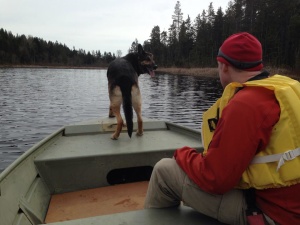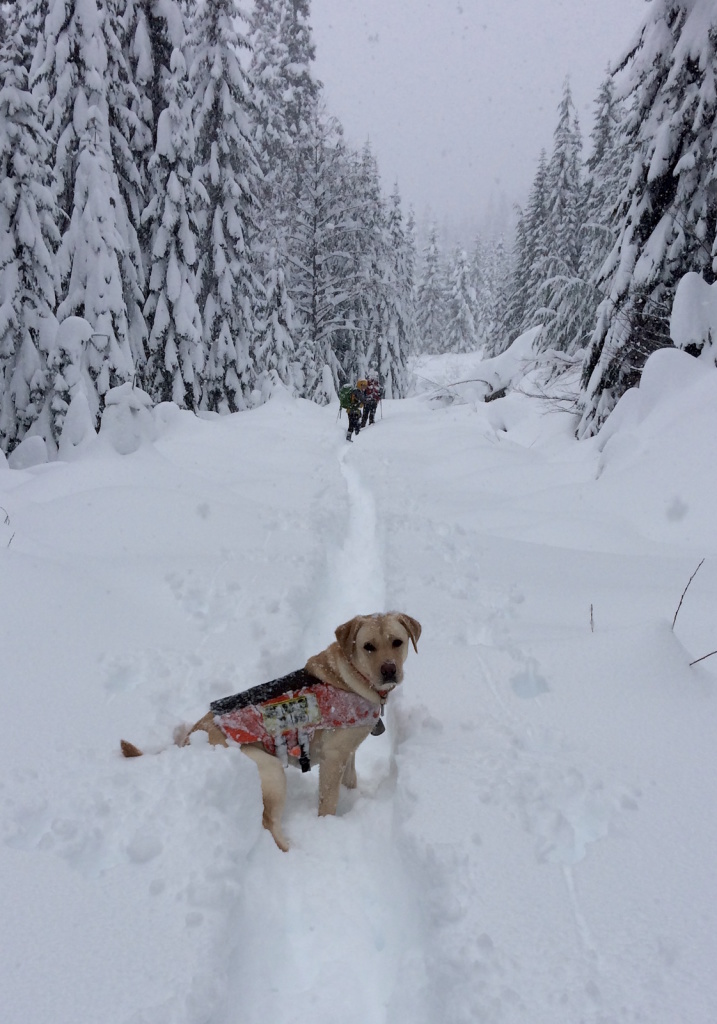Human Remains Detection (HRD or Cadaver) is the third core discipline of King County Search Dogs. The stages of decomposition begin shortly after death and produce a complex series of volatile chemicals. Many of these are species-specific and HRD dogs are trained to discriminate between human and wildlife remains encountered in a search. Tissue, fluid and bone each produce distinct olfactory mixtures that can vary depending on the environment and the passage of time. Not surprisingly bone is the most enduring type of remains and search dogs can detect buried, dried bone fragments several years after all other traces are gone.
HRD dogs often work off leash but in closer quarters to the handler than airscent dogs. They use a passive indication in the presence of human remains such as a sit or a down in order to preserve the scene for possible further investigation. HRD requires excellent handler-dog teamwork as the handler must be able to ‘read’ subtle clues of the dog’s interest in an area and then allo the dog to focus in and identify the exact location. Training begins by teaching the desired indication behavior and rewarding a dog when it shows interest in a known scent source. It progresses through stages of using older and smaller sources hidden in increasingly difficult places. Handlers always keep it a game for the dog by enthusiastic play or food reward when the dog indicates properly.
Once KCSD dog-handler teams certify in a core search discipline (airscent, trailing or HRD) they can begin training in a specialty area such as water searching, avalanche rescue or disaster. Each of these skills is a demanding but important facet of the services KCSD provides to the community.
Natick’s specialty is “Mud-Searching”
Water Searching.

Many decomposition products are gaseous and will rise to the surface of a lake or pond and become airborne. For water searches, HRD dogs are trained to ride in the front of a small boat and/or search the shoreline on foot. The dogs are trained to indicate where they detect human remains for subsequent detailed search by divers. This strategy allows a large body of often low visibility water to be examined more quickly and more efficiently than divers doing a grid search.
Avalanche Rescue. Avalanche dogs usually work off lead and are taught to indicate the presence of a buried subject after which the search team may use long poles to confirm and shovels to quickly uncover the victim. Training includes having the dogs search for volunteers (dressed very warmly and equipped with radios and locator beacons) buried in snow caves. Washington is fortunate to have several specialty avalanche search dog groups associated with ski patrol units including: Alpental BARK (Backcountry Avalanche Rescue K9s), Stevens Pass Avalanche Rescue Dogs and Crystal Mountain’s Avalanche Dogs.

Time is the critical factor for anyone buried in an avalanche. For victims who survive the trauma of the initial avalanche, the survival rate drops by 50% for each succeeding 30 minutes they are buried. Even with the increasing use of personal locator devices, trained avalanche dogs are a time-tested, invaluable aid in locating avalanche victims. It is challenging work because access to the slide site can be difficult and dangerous and because avalanche snow compacts generating a formidable barrier to the release of the victim’s scent and limiting the ability of the victim to breathe.
Disaster Rescue. Natural and man-made disasters can result in subjects being trapped in collapsed buildings or in flood, tsunami or landslide debris. Finding and rescuing victims is time sensitive but the search site is often hazardous. Disaster dogs are taught to work away from their handlers carefully navigating unstable surfaces. The handler may direct the dog’s search pattern with commands much like a sheepdog and the dog is usually taught to indicate where they have found a subject’s scent by barking rather than risking multiple trips across a rubble pile in a re-find response.
King County Search dogs participated in the efforts after the tragic 2014 landslide in Oso, Washington alongside search teams from Snohomish and other neighboring counties. These efforts were part of the critical early response before most FEMA search dog teams were able to arrive. Northwest Disaster Search Dogs continues to serve this area with certified disaster search and rescue work and you can find out more about the nationwide network of disaster search dog groups at DisasterDog.org.


